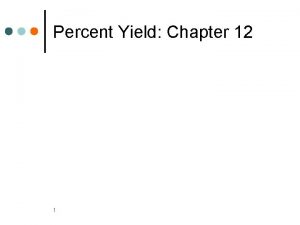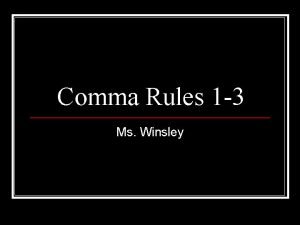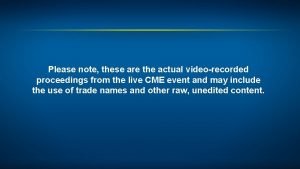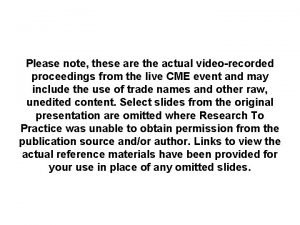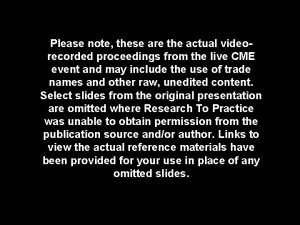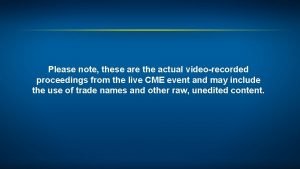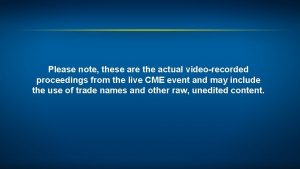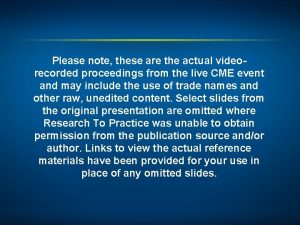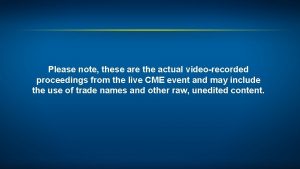Please note these are the actual videorecorded proceedings

























- Slides: 25

Please note, these are the actual video-recorded proceedings from the live CME event and may include the use of trade names and other raw, unedited content.

Role of PARP Inhibitors, Novel Agents in m. BC; Male Breast Cancer Tiffany A. Traina, MD Clinical Director, Breast Medicine Service Section Head, TNBC Clinical Research Program Associate Attending Memorial Sloan Kettering Cancer Center June 3, 2019

Disclosures Consulting Agreements Aduro Biotech, Advaxis Inc, Astellas Pharma Global Development Inc, Astra. Zeneca Pharmaceuticals LP, Athenex, Bristol-Myers Squibb Company, Celgene Corporation, Genentech, Genomic Health Inc, Halozyme Inc, Innocrin Pharmaceuticals Inc, Medivation Inc, a Pfizer Company, Merck, Pfizer Inc, Puma Biotechnology Inc, Roche Laboratories Inc, Samsung Bioepis Contracted Research Astellas Pharma Global Development Inc, Astra. Zeneca Pharmaceuticals LP, Daiichi Sankyo Inc, Eisai Inc, Genentech, Immunomedics Inc, Innocrin Pharmaceuticals Inc, Novartis, Pfizer Inc, Roche Laboratories Inc Speakers Bureau Genentech, Roche Laboratories Inc

A woman in her early 60 s (Dr Traina) • 20 years ago: ER-positive DCIS BCS, RT and tamoxifen x 5 years • 8 years ago: 1. 8 -cm, node-negative TNBC bilateral mastectomy, adjuvant TAC – Pathogenic BRCA 2 mutation • Risk-reducing BSO • 2/2018: Right chest wall recurrence with nodular rash across prior irradiated field and beyond – Biopsy-proven metastatic TNBC not amenable to resection or additional RT • Olaparib monotherapy – 4/2018: CR • 5/2019: Continues olaparib, NED

A woman in her early 70 s with g. BRCA wild-type AR-positive metastatic TNBC (Dr Traina) • 12/2007 - 4/2008: TNBC bilateral mastectomy, SLNB adjuvant TC x 4 • 2016: Metastasis to sternum, uncertain pulmonary metastases – Sternum biopsy: AR 90% TNBC • 3/2016: Investigational antiandrogen partial response – 2/2019: Discontinued study drug • Remains on observation per patient preference

A man in his early 60 s with ER/PR-positive, HER 2 -negative metastatic breast cancer who has a strong family history of ovarian cancer and a g. BRCA 2 mutation (Dr Traina) • 9/2016: Primary ER/PR-positive, HER 2 -negative right breast cancer and bone mets • 10/2016: Tamoxifen and denosumab • 3/2017: Progressive disease in lung, LN, bone, chest wall nab paclitaxel • 8/2018: Progressive disease presented for consideration of trials – Germline BRCA testing: BRCA 2 – Somatic mutation analysis: No actionable targets • 9/2018: Clinical trial — CYP 17 antagonist • 2/2019: Progressive disease increased mass in R breast, thoracic adenopathy • Olaparib monotherapy – Symptomatically improved by cycle 2, mild nausea

Topics • PARP inhibitors in MBC – FDA-approved agents – Other PARP inhibitors under investigation • Novel agents for metastatic TNBC – Antibody Drug Conjugates – AKT inhibitors – AR antagonists • Male Breast Cancer

Olympi. AD: Phase III trial of olaparib in g. BRCA mutation associated breast cancer Olaparib 300 mg tablets BID TPC: Capecitabine Eribulin Vinorelbine Primary endpoint: PFS by blinded independent central review (BICR) Robson et al, NEJM 2017

Olaparib associated with a 42% increase in median PFS as compared to treatment of physician’s choice 4. 2 mo 7 mo Robson et al, NEJM 2017

1 0 Overall survival in prespecified subgroups No prior chemotherapy for m. BC (1 L) Deaths, n (%) Median OS, mo Prior chemotherapy for m. BC (2/3 L) Olaparib TPC 30 (50. 8) 21 (75. 0) 22. 6 14. 7 Deaths, n (%) Probability of overall survival 0 4 8 12 16 Alive at 6 mo, % 93. 2 88. 5 62. 1 46. 2 Median follow-up, mo 25. 5 26. 9 24 28 32 100 (68. 5) 41 (59. 4) 18. 8 17. 2 HR 1. 13 (95%CI 0. 79– 1. 64; p = NS) Alive at 18 mo, % 20 TPC Median OS, mo HR 0. 51 (95%CI 0. 29– 0. 90; p = 0. 02) 1. 0 0. 9 0. 8 0. 7 0. 6 0. 5 0. 4 0. 3 0. 2 0. 1 0. 0 Olaparib 36 40 Time from randomization (months) OS in ITT: 17. 1 mo vs. 19. 3 (HR 0. 90; 95% CI 0. 66– 1. 23; p = 0. 513) 1. 0 0. 9 0. 8 0. 7 0. 6 0. 5 0. 4 0. 3 0. 2 0. 1 0. 0 0 4 8 12 16 Alive at 6 mo, % 93. 1 84. 9 Alive at 18 mo, % 50. 8 48. 8 Median follow-up, mo 25. 2 26. 0 20 24 28 32 Time from randomization (months) Robson et al AACR 2018 36 40

EMBRACA: Phase III trial of talazoparib in g. BRCA mutation associated BC Talazoparib 1 mg daily 2: 1 N=431 Litton et al SABCS 2017 TPC: Capecitabine Eribulin Vinorelbine Gemcitabine

Talazoparib increased m. PFS by 46% Events, no. (%) TALA Overall PCT 1 -Year PFS 37% vs 20% m. PFS 5. 6 mo vs 8. 6 mo Litton et al NEJM 2018 Median, mo (95% CI) TALA (n = 287) Overall PCT (n = 144) 186 (65%) 83 (58%) 8. 6 (7. 2, 9. 3) 5. 6 (4. 2, 6. 7) Hazard ratio, 0. 54, 95% CI, 0. 41, 0. 71 P <. 0001

Summary (Olympi. AD and EMBRACA) Olympi. AD EMBRACA HR (PFS) 0. 58 (0. 43 -0. 80) 0. 54 (0. 41 -0. 71) HR (OS) 0. 90 (0. 66 -1. 23) 0. 76 (0. 54 -1. 06) HR (OS) 1 st Line setting 0. 51 (0. 29 -0. 90) NR 59. 9% (vs 28. 8% TPC) 67. 6% (vs 27. 2% TPC) 0. 44 (0. 25 -0. 77) 0. 38 (0. 26 -0. 56) 36. 6% (vs 50. 5% TPC) 25. 5% (v. 25. 4% TPC) Anemia ≥ Grade 3 16. 1% 39. 2% Neutropenia ≥ Grade 3 9. 3% 20. 9% Thrombocytopenia ≥ Grade 3 2. 4% 14. 7% 0 0 Nausea (any grade) 58. 0% 48. 6% Alopecia (any grade) 3. 4% 25. 2% ORR Deterioration HRQo. L SAE ≥ Grade 3 MDS/AML

Next steps in PARP inhibition Extending PARPi therapy Other PARPi in development • Combinations (conventional cytotoxics) • Combinations (targeted agents) • Veliparib – – PIK 3 CAi VEGF (e. g. cedirinib) Increase replication stress (ATMi, ATRi) IO (innate immunity? ) • Early stage disease (adjuvant olaparib, neoadjuvant talazoparib) • Other genes, somatic mutations – Brigh. TNess: C+P+V vs. C+P vs. P Neoadjuvant TNBC AC. • – Addition of V did not inc p. CR BROCADE: C+P+V vs. C+P in met g. BRCA • Niraparib – BRAVO: Niraparib vs. TPC in met g. BRCA. Closed early and has not reported • Rucaparib – Phase II of rucaparib in patients with metastatic BC with high loss of heterozygosity/HRD

Brigh. TNess: Phase III trial evaluating addition of veliparib + carboplatin or carboplatin alone to neoadjuvant chemotherapy in TNBC — p. CR results Loibl S et al. Lancet Oncol 2018; 19(4): 497 -509.

TOPACIO (KEYNOTE-162): Phase II trial of niraparib + pembrolizumab in metastatic TNBC Biomarker-selected populations Efficacy evaluable patients ORR (CR+PR) DCR (CR+PR+SD) t. BRCAmut patients (n=15) 9 (60%) 12 (80%) HRRmut + t. BRCAmut (n=20) 11 (55%) 16 (80%) PD-L 1 -positive patients (n=25) 9 (36%) 13 (52%) Overall response rate in all (biomarker-unselected) patients (N=46): 28%, DCR: 50% Vinayak S et al. ASCO 2018; Abstract 1011

Engineering ADCs in TNBC • The target – – Selectivity Level of expression ADC internalization Intracellular trafficking • The linker – Cleavable vs. non-cleavable • The payload – Tubulin directed – DNA damaging

Sacituzumab: TNBC Efficacy m. TNBC, ≥ 2 priors, s/p taxane. No biomarker selection. N=110 ORR 34%, Do. R 7. 7 mo Bardia et al, NEJM 2019

ASCENT: Randomized Phase III Completed Accrual TROPICS-02: Launch of Ph III trial in ER+ MBC NCT 03901339

Other ADCs in TNBC… trastuzumab deruxtecan Trastuzumab deruxtecan DS-8201 a DAR = 8 Poster # P 6 -17 -02 – San Antonio Breast Cancer Symposium® – December 4– 8, 2018 HER 2 “low”

Other ADCs in TNBC… ladiratuzumab vedotin • • • Metastatic TNBC, ≥ 2 prior chemotherapy Results: ORR 25%, m. PFS 11 weeks (95% CI, 6 -12 weeks) Treatment related AEs, all grade: alopecia 41%, neutropenia 25%, neuropathy 20%, vomiting 24% Forero et al SABCS 2016, Modi et al SABCS 2017

AKT inhibition in 1 st line m. TNBC Paclitaxel +/- capivasertib PFS ITT N=138 4. 2 vs 5. 9 m. HR 0. 74 (0. 5, 1. 08) p = 0. 06 OS 12. 6 vs 19. 1 m. HR 0. 61 (0. 37, 0. 99) p = 0. 02 PIK 3 CA/AKT 1/ 3. 8 vs 9. 3 m. PTEN Altered HR 0. 3 (0. 11 -0. 79) p = 0. 01 N=28 10. 4 vs NR. PIK 3 CA/AKT 1/ 4. 4 vs 5. 3 m. HR 1. 13 (0. 7, 1. 82) PTEN WT p = 0. 067 N=84 13. 2 vs 16. 6 m. HR 0. 37 (0. 12 -1. 12) p = 0. 61 HR 0. 84 (0. 48, 1. 49) p = 0. 56 Schmid, et al, ASCO 2018; Kim et al, Lancet Onc 2017 Ipatasertib PIK 3 CA/AKT/PTEN altered m. PFS 4. 9 mo vs. 9 m

AR as a target in TNBC AR >0% AR >10% CBR 24 CBR 16 m. PFS Bicalutamide 1 — 12% 19% — 12 wks Enzalutamide 2 79% *55% *29% *35% *14. 7 wks — 38% 20% — 11. 2 wks Abiraterone 3 Seviteronel 4 Phase I published; Phase II manuscript in preparation Bicalutamide + palbociclib 5 Phase I completed; Phase II ongoing Enzalutamide + taselisib Phase I complete 1 Gucalp et al. CCR. 2013; 2 Traina et al. J Clin Oncol. 2018; 3 Bonnefoi et al. Annals Oncol. 2016; 4 Gucalp et al ASCO 2017; 5 Gucalp et al SABCS 2017

Male Breast Cancer • International Male Breast Cancer Program – 20 years, 93 centers, 9 countries • Characterization of Male Breast Cancer • N=1822 Cardoso F et al Ann Oncol 2018; Gucalp et al Breast Ca Res Treat 2019 Median age @ dx 68 y M 1 5% 85% invasive ductal ca Majority (49%) luminal B 99. 3% ER+, 82% PR+ Only 77% received adjuvant endocrine tx • Only 4% had BCS • ER, PR, AR associated with OS and RFS. Grade, Ki 67, IHC surrogates did not. • • •

Hope for patients with metastatic TNBC PARP inhibitors for g. BRCAm Antibody drug conjugates AKT inhibitors Checkpoint inhibitors AR antagonists Trastuzumab Pertuzumab TDM 1 Lapatinib Neratinib DS 8201 a Tamoxifen Aromatase inhibitors Fulvestrant CDK 4/6 inhibitors PI 3 K inhibitors ER+ HER 2+ TNBC
 Antigentest åre
Antigentest åre Divorce law in india
Divorce law in india Flow chart of court proceedings in the philippines
Flow chart of court proceedings in the philippines Meeting adjournment
Meeting adjournment To stop proceedings temporarily; move to another place
To stop proceedings temporarily; move to another place Difference between actual yield and theoretical yield
Difference between actual yield and theoretical yield Definition of sanctifying grace
Definition of sanctifying grace Will you please be quiet please summary
Will you please be quiet please summary Ms.winsley
Ms.winsley Difference between note making and note taking
Difference between note making and note taking Financial documents order
Financial documents order Note making advantages
Note making advantages Difference between note making and note taking
Difference between note making and note taking Debit note format
Debit note format Simple discount
Simple discount Singnal words
Singnal words Nota debit adalah
Nota debit adalah Voi kéo gỗ như thế nào
Voi kéo gỗ như thế nào Thiếu nhi thế giới liên hoan
Thiếu nhi thế giới liên hoan Fecboak
Fecboak điện thế nghỉ
điện thế nghỉ Một số thể thơ truyền thống
Một số thể thơ truyền thống Thế nào là hệ số cao nhất
Thế nào là hệ số cao nhất Slidetodoc
Slidetodoc Hệ hô hấp
Hệ hô hấp Các số nguyên tố
Các số nguyên tố





